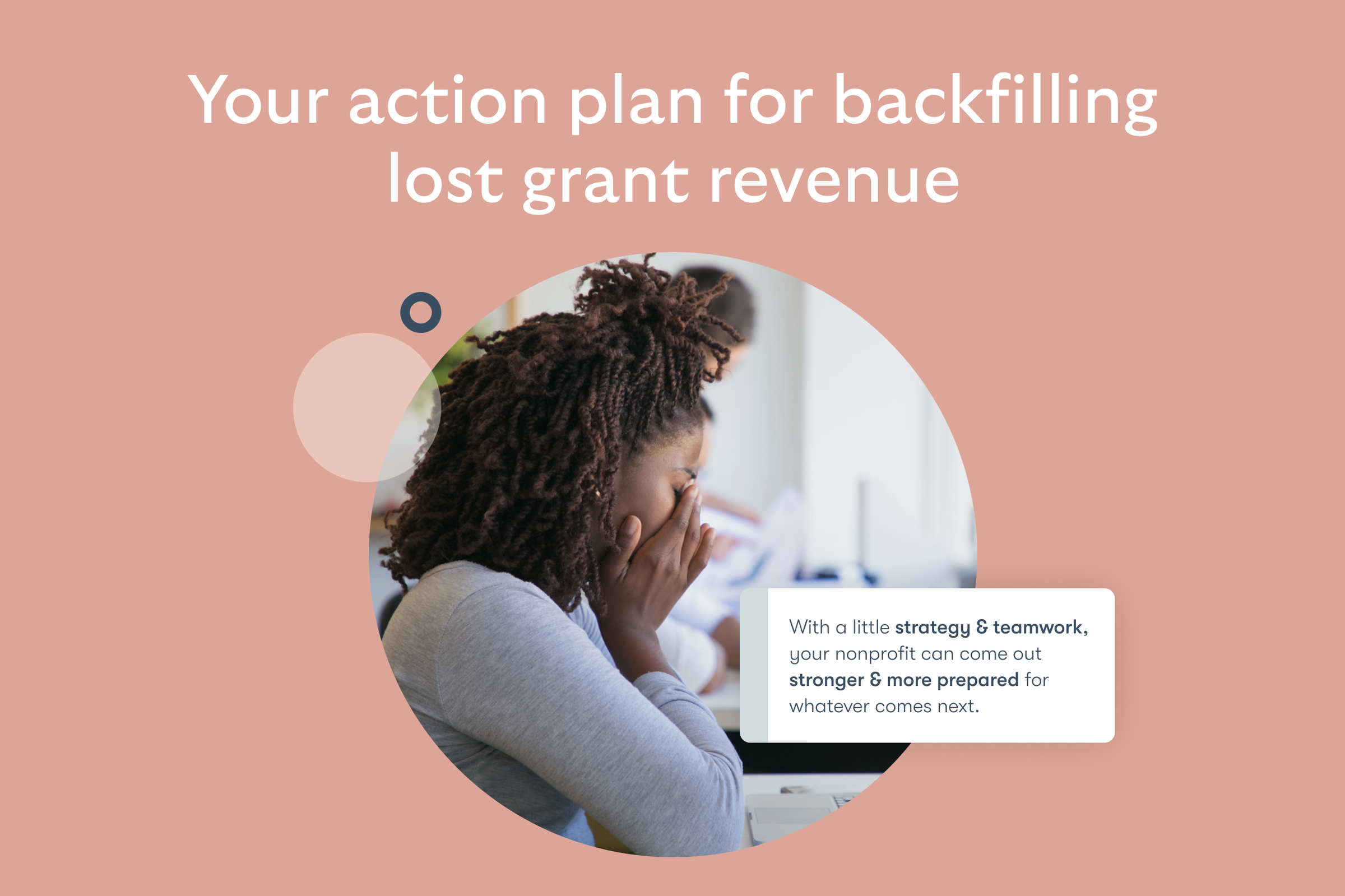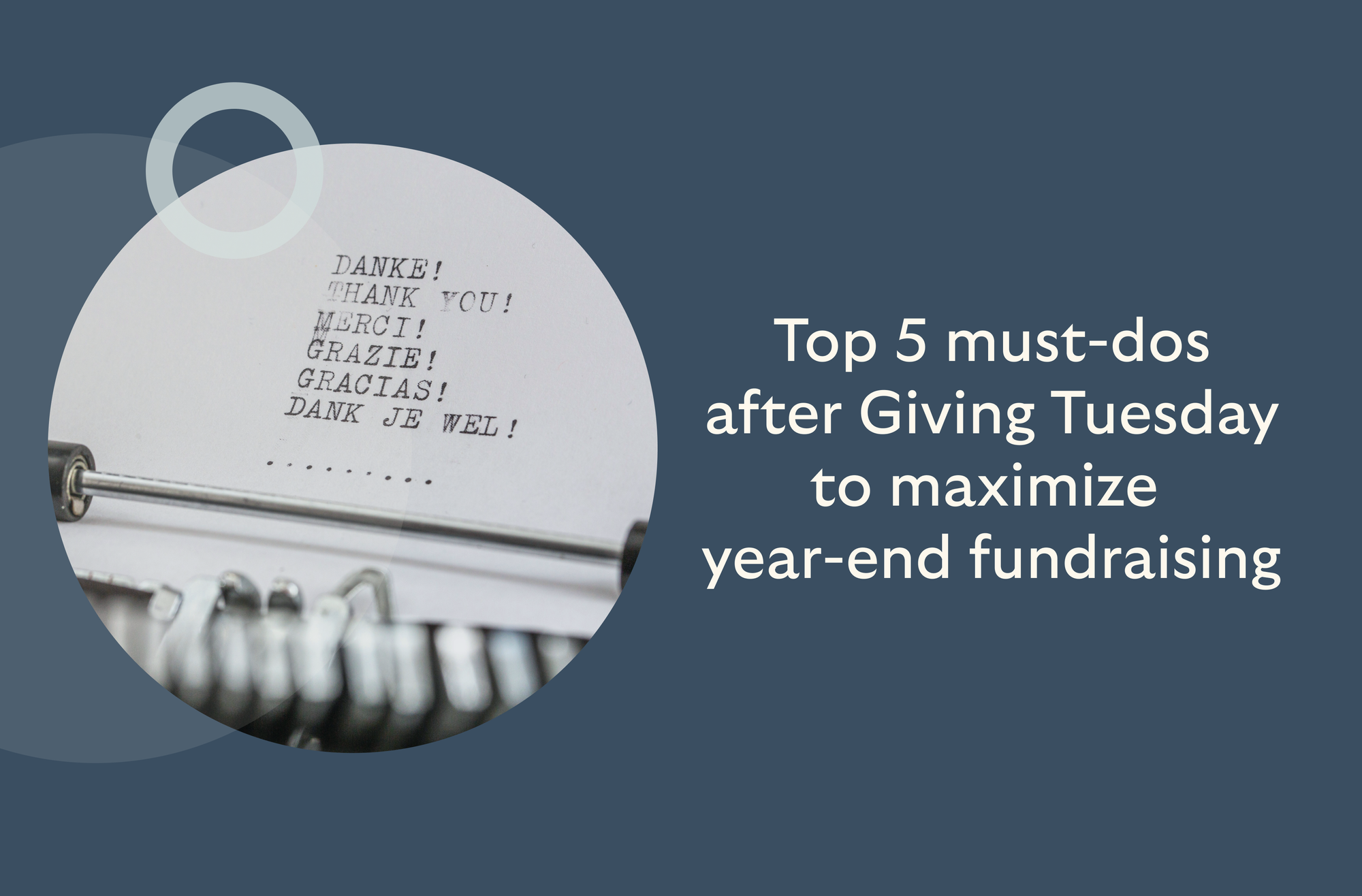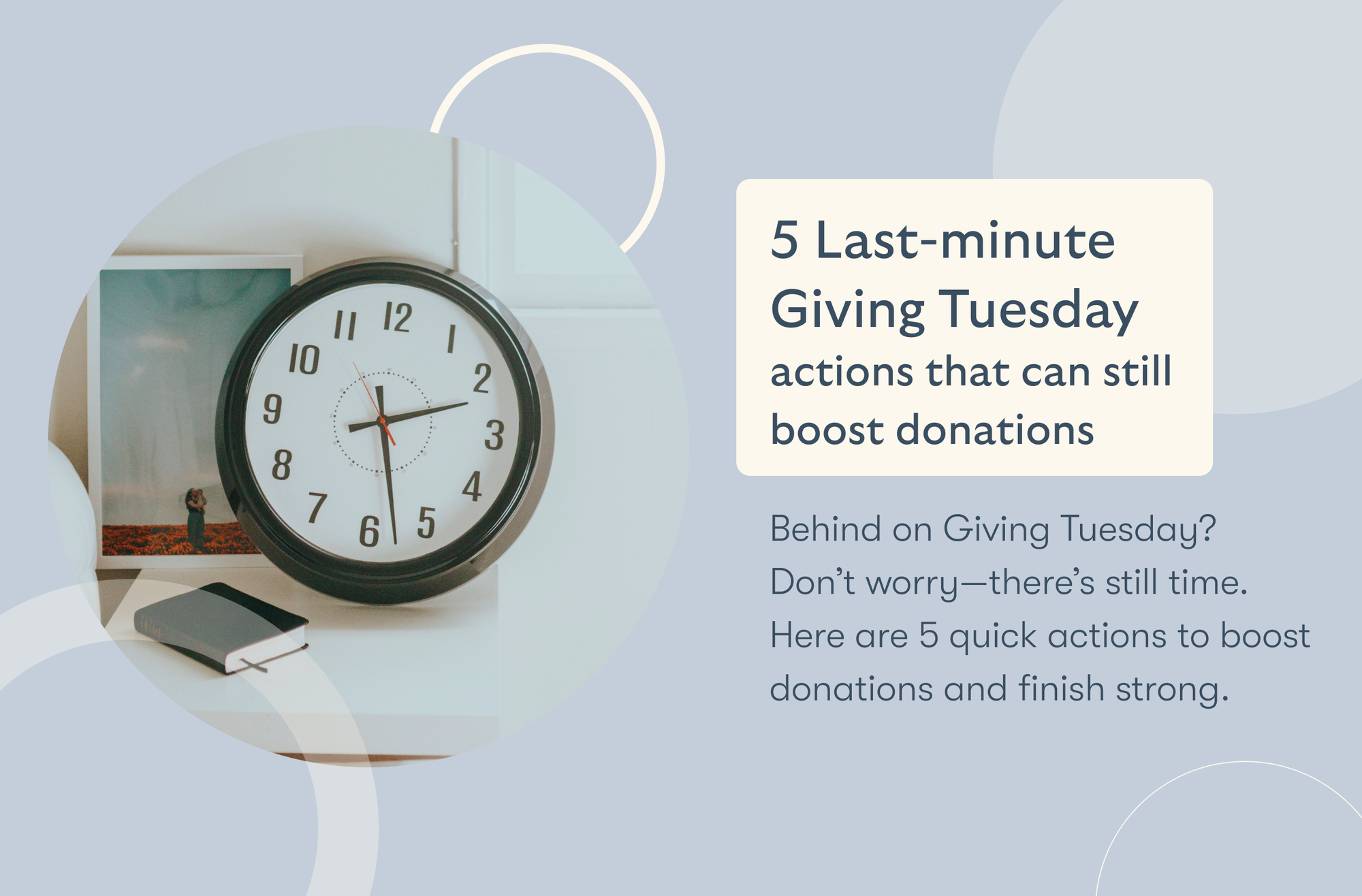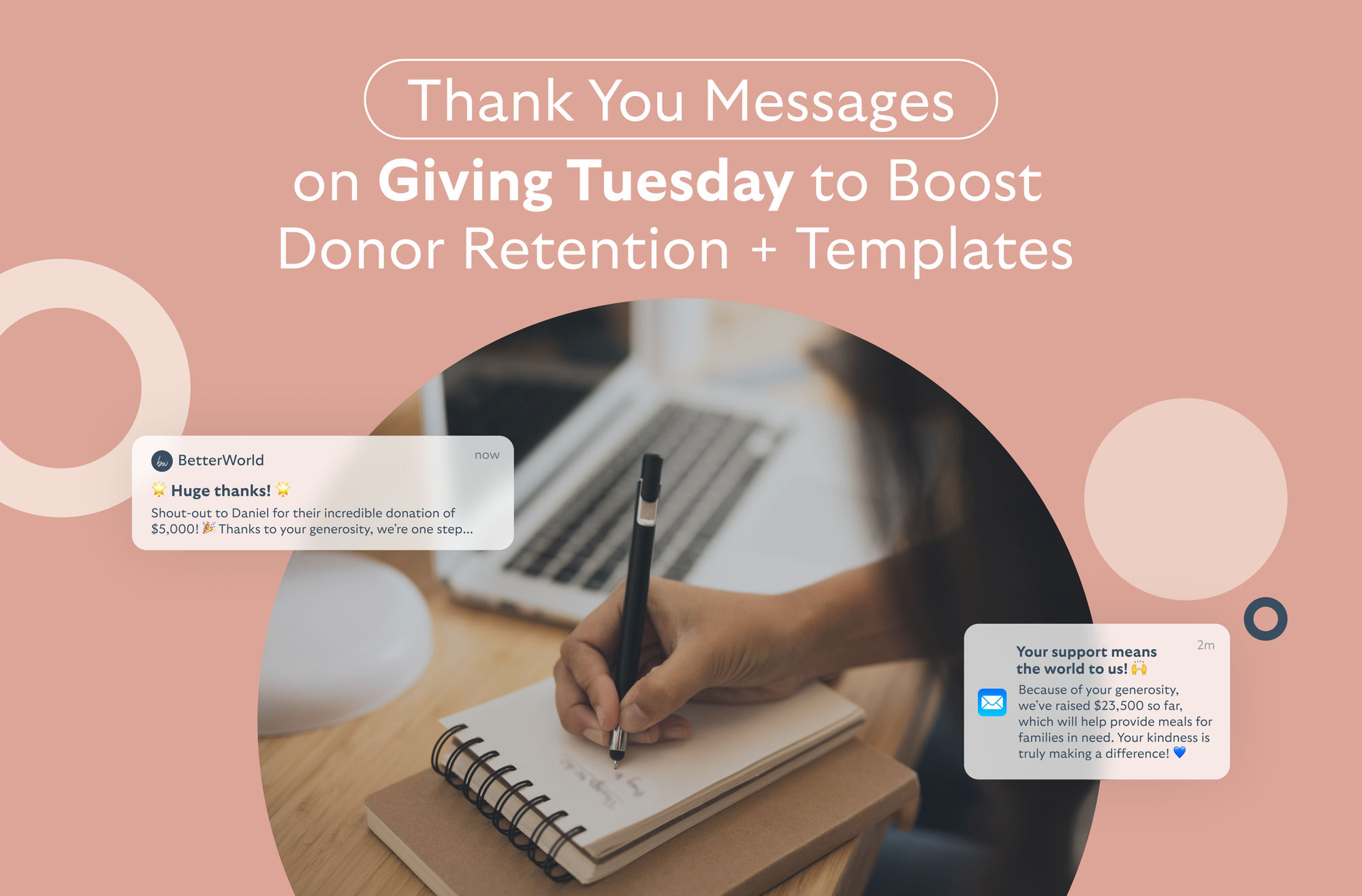Video Integration — boost the buzz around your online fundraising campaign
Time-saving – thoughtful automations save dozens of hours over your campaign
One-Click Checkout — our system will automatically charge the lucky winner
Text Message Notifications — keep your bidders engaged with text message notifications
Your action plan for backfilling lost grant revenue
By Colin Hunter

Losing grant revenue can feel like a big setback, especially if your programs rely on that funding. But it doesn’t mean everything has to stop.
Many nonprofits experience this at some point, and the good news is that there are ways to recover. You just need a clear action plan to help you stay steady while you look for new support. From trimming costs to exploring new income options, small steps can make a big difference.
If you're wondering how to get funding for a nonprofit again or need to explore other funding routes, this guide will walk you through what to do next.
Analyze the Full Impact of Lost Grant Revenue
1. What the Loss Means for Your Nonprofit
A lost grant can have a ripple effect on your entire organization. To fully understand what you’re dealing with, start by breaking down the grant’s role in your budget.
List exactly what the grant paid for. Did it cover full-time salaries, supplies, program delivery, transportation, or admin costs? If the grant made up 20%, 40%, or even more of your total revenue, losing it might mean you must pause or cancel key services.
Go beyond the numbers. What communities or groups will feel the change the most? Which goals or partnerships are now at risk? Are there legal or contractual obligations tied to that grant-funded work?
According to the Urban Institute, around 60% to 80% of nonprofits that rely on government grants face financial shortfalls when major funding shifts happen. That’s a reminder of why backup plans matter.
As you assess the damage, learn how to get funding for nonprofits that match your mission. But don’t just look for money—look for stability.
2. Measure the Financial Impact
To move forward, you need real numbers, not guesses. Start by writing down the full amount of the grant. Then, list every line item covered by the grant.
Separate it into fixed costs (like salaries or rent) and flexible costs (like supplies or travel). This gives you a clear view of what’s now missing.
Next, calculate the percentage of your total annual budget the grant made up. For example, if your budget is $200,000 and the lost grant was $50,000, that’s 25%. That number helps you understand how big the gap really is.
Now, map out the timeline. If the grant ends in 3 months, you have a short runway. If it ended last month, you’re already in the gap. List how long you can keep running programs with current reserves.
Also, figure out if any of your other funding sources are tied to this grant (like matching funds). If so, you may lose more than just one stream.
Once the gap is measured, you’ll be in a better place to figure out how to find grants for nonprofits that can realistically fill that space, either short-term or for the long haul.
3. Set Your Program Priorities
After measuring the financial gap, the next step is figuring out what matters most right now. You probably can’t fund everything as you used to, so it’s time to make some hard but smart choices.
Start by listing all your current programs. Which ones are core to your mission? Which ones serve the most people or have the most significant impact? Keep those at the top. These are the programs you want to protect.
Next, look at which programs can be adjusted. Can anything be scaled back, paused, or combined with another activity? Not everything has to stop, but some things may need to slow down while you regroup and reassess.
Also, ask what’s already funded and what’s not. If a program depends entirely on the lost grant, it might need to be paused unless you find quick support elsewhere.
This sorting helps you use the money you do have in a focused way and clearly explain your needs to donors and grantmakers.
If you’re trying to find grants for nonprofits that match your goals, having your priorities in order will make it easier to apply for the right ones without wasting time.
Communicate With Stakeholders
1. Internal Teams and Staff
Your team needs to know what’s happening, not just because it affects their roles but also because they are part of the solution.
Be honest about the lost grant, how it impacts the budget, and what might change in the short term. Clear, respectful communication helps avoid confusion or fear.
Staff may have useful ideas for cutting costs, adjusting programs, or even reaching out to new partners. If your team knows the plan, they can work together more effectively.
It also helps them stay motivated during a tough time. Share steps you’re taking, like revisiting budgets or exploring how to find grants for nonprofits that fit your mission. People work better when they know the goal and see a path forward.
2. Board Members
Your board can do more than approve decisions—they can be part of the solution. Bring them into the conversation early.
Lay out the situation clearly: the grant has ended, here’s the financial impact, and here’s where support is needed. Ask them to help review the budget, share connections, and suggest ways to keep key programs running.
Some board members may be able to contribute personally or introduce you to funders. Others may have experience in similar situations and can guide the next steps.
This is also a chance to revisit your fundraising strategy together and talk about how to get funding for a nonprofit from new sources. A strong board can give your plan both direction and support.
3. Donors and Supporters
Don’t wait too long to tell your donors about the funding gap. Let them know what happened, why it matters, and what they can do to help.
Keep the message simple and honest. Explain which programs are at risk and how their support can keep them going. People are more likely to give when they feel included and trusted.
Offer options—monthly donations, one-time gifts, or even help spreading the word. Your donors care about your mission. They won’t know how to help unless you tell them what you need.
Explore Emergency Funding Options
1. Use Reserves or Operating Surplus
If your nonprofit has built up reserves or has an operating surplus, now might be the time to use them. These funds are often set aside for unexpected situations like losing a major grant.
Nearly 4 in 10 nonprofits have no emergency cash reserves, so having savings already puts you in a stronger position than many others.
Use them carefully. Focus on keeping essential programs going while you work on a long-term plan. Using reserves should come with a recovery timeline so you know how long the funds will last.
Also, use this time to review your expenses and see where cuts can happen without hurting your core mission. While these funds buy you some time, they aren’t the answer. As you stabilize, start mapping out how to find funding for nonprofits to help fill the gap without burning your reserves.
2. Short-Term Loans or Bridge Funding
Bridge funding or short-term loans can help you cover costs for a few months, especially if you’re waiting on a new funding cycle.
But be careful—borrowing money puts pressure on your budget, and repayment deadlines come fast. Only consider this option if you have a clear plan to repay it and are confident about income from another confirmed source, like a grant renewal or an upcoming campaign.
Talk to your board or finance committee before moving forward. This option is not a permanent solution, but it may give you time to organize and explore alternative funding sources for your nonprofit.
3. Reapply or Appeal
Some grants come with the chance to reapply or file an appeal, especially if the loss came from a missed deadline or incomplete report.
Go back to the funder’s guidelines and see if there’s room to reopen the discussion. Reach out directly, explain your situation, and ask if emergency or renewal funding is available.
Even if it doesn’t work this time, you show initiative and keep the relationship strong for future cycles. Also, check for rolling applications; some funders accept new proposals year-round.
While doing this, don’t forget to research where to find grants for nonprofits that offer emergency or unrestricted support.
4. Partner with Local Funders or Collaboratives
Community foundations, giving circles, or local collaboratives often step up in times of need, especially for programs serving at-risk groups.
These funders usually have flexible criteria and quicker response times. They may also offer introductions to other donors or shared grant opportunities with other nonprofits.
Look for partnerships that benefit both sides, such as joint events or shared resources. Even if you don’t get large amounts, small grants from local sources can keep things going.
Plus, they help you build trust in your area. As you rebuild, keep track of these connections, as they often lead to ideas on how to find funding through regional networks.
Launch a Fast Fundraising Campaign
If you’ve just lost a grant, you don’t always have the luxury of waiting months for new funding.
That’s where a fast fundraising campaign comes in.
It won’t solve everything, but it can help cover the gap while you regroup, talk to funders, and explore longer-term options. The goal here is speed, simplicity, and clear communication.
Here are some of the Best Fundraising Ideas For Nonprofits To Raise Money Fast.
1. Host a “We Need You Now” Campaign
This is a short, focused campaign with a direct ask. This campaign is about reaching out to your community with one clear message: We need your help to keep going.
Choose a specific amount to raise and explain what that money will do. Will it keep one key program open? Will it help cover funding for the next two months? The more specific you are, the better.
Keep the timeline short—no more than 2 to 3 weeks. People respond better when there’s a deadline. Use a campaign name that feels urgent but hopeful, like “Help Us Bridge the Gap” or “Keep Our Work Going.”
Make it easy for people to donate. Set up a quick donation page, keep the form short, and allow one-time and recurring gifts.
Low on budget? Launch a free fundraising campaign with BetterWorld's Modern Fundraising Tools and Online Fundraising Software. Keep all the funds you raise with no hidden costs. Sign up today!
2. Use Email and Social Media
Start with those who already care about your work, email list, social followers, and volunteers. Let them know exactly what happened and what they can do to help.
Keep the message simple, honest, and personal. Avoid general language like “support our cause” and instead say, “Your gift today will help us serve 100 families this month.”
Don’t send just one email or post once and wait. Plan out a short series, consisting of three to five messages, over a period of two weeks. Use real stories and updates to keep people engaged. You can even ask board members or staff to record short videos explaining what’s going on and how support helps.
Encourage monthly gifts if possible. Even $10 a month makes a difference; recurring donations help you stabilize your income over time.
3. Create a Mini-Matching Gift Drive
If you have a major donor, business partner, or foundation supporter, ask them to match donations during the campaign.
Highlight the match everywhere, such as on your donation page, emails, and social media. Say something like, “Every dollar you give today will be doubled.”
Matching drives create momentum. They also give you a reason to send reminders without sounding pushy. And they help turn small gifts into something bigger, both in funds raised and donor confidence.
While you run this campaign, also begin working behind the scenes to find grants for nonprofits that can help support you long term. Fast fundraising fills the gap, but smart planning keeps the doors open.
Strengthen Recurring Donation Programs
Did you know that Recurring donors have about a 77% year-over-year retention rate, compared to only 34% for one-time donors.
A recurring donation program can fill the gap while figuring out how to find grants for nonprofits that support your long-term goals.
Let us help you raise more! Use BetterWorld’s free, easy fundraising tools!
1. Why Monthly Donations Matter
Monthly donations help nonprofits plan better. Instead of starting each month unsure about your income, you know what’s coming in.
That means you can budget for staff, supplies, and services without last-minute scrambling. And donors who give monthly often stay connected longer than one-time givers—they become regular supporters of your mission.
Recurring gifts also spread out the ask. It’s easier for someone to give $15 a month than $180 all at once. Over time, that adds up and creates a more balanced funding base that doesn’t rely on a few large sources.
2. How to Start One Quickly
Use tools that are ready to go. BetterWorld’s Donation Forms lets you launch a monthly donation page in minutes. There’s no setup cost, and it’s built for nonprofits.
You can add preset monthly amounts, share the impact of those gifts, and track all donations in one place.
If you're also looking into how to find funding for nonprofits, this is a good way to stay afloat while you wait for those opportunities to come through. It gives you room to breathe without pausing your work.
3. Promote It Everywhere
Once it’s set up, make recurring giving a part of all your communications. Add it to your email footer. Mention it in your thank-you messages. Pin a post about it on your social media. Even during events, take a moment to talk about monthly giving.
Use real examples. Say, “$25 a month helps keep a child in after-school programs.” The clearer you are, the more likely people will sign up.
Recurring donations won’t replace a lost grant overnight—but they help you rebuild stronger and prepare for the next funding challenge.
Identify New Grant Opportunities
Instead of focusing only on what’s lost, this is the time to look for new support.
With the right tools and plan, you can find funding that fits your work better than before. Here’s how to move forward.
1. How to Find Grants After a Loss
The first step is knowing where to find grants for nonprofits that match your mission and current needs.
A few trusted tools can make your search much easier. Platforms like GrantStation, Candid, and the Foundation Directory Online offer searchable databases of private, corporate, and government funders. You can filter by issue area, location, or funding type.
Sign up for newsletters from grant platforms or nonprofit support networks in your state. They often share new opportunities as they open. And don’t ignore past funders who said no. Revisit them with updated information, especially if your current needs now align with their giving areas.
If you’re not sure how to find grants for nonprofits that fit your mission, start by searching by need—education, youth programs, housing, health, and so on. Also, look at who funds nonprofits like yours. Visit their websites and study their recent grantees.
One overlooked tip: check the annual reports of similar organizations. They often list major funders by name, giving you a direct lead.
Read our guide on How to Write a Perfect Grant Proposal in 8 Steps.
2. Explore Local Government and Corporate Grants
Big national grants attract considerable attention, but local opportunities are often easier to find. City and county governments may offer small grants for community programs, education, public health, or outreach.
These may not replace a lost grant entirely, but several small wins can keep you going.
Also, check with local businesses. Many have corporate social responsibility (CSR) programs that support nonprofits in their area. These are often tied to the company’s goals, like youth sports, education, or environmental work, but they may be open to new ideas.
Visit business websites or reach out to their community engagement staff. Don’t just ask for money—start a conversation and share what you’re doing locally.
Even if the funding is modest, a local corporate grant can open the door to partnerships, volunteers, or in-kind support.
3. Prepare a Stronger Grant Application
Now that you know what losing grant revenue feels like, your next applications should reflect what you’ve learned.
Start by updating your case for support. Include how the lost grant impacted your programs, what steps you’ve taken since, and why you’re looking for new funding now. Funders respect honesty, especially when paired with a clear recovery plan.
Also, make sure your financial documents, impact data, and staff list are up to date. If you had trouble before with reporting or outcomes, tighten that part of your application. Show that you’re ready and able to manage new funds responsibly.
Make sure your financials and outcomes are recent and easy to understand. A common mistake is sending outdated documents or unclear program goals. Also, each application should be tailored. Funders can tell when you reuse the same language across multiple proposals.
Finally, focus on readiness. If reporting was a weak point before, build a simple system now. Show funders that you're not just chasing money—you’re ready to manage it well
The process takes time, but it pays off. Knowing how to find grants for nonprofits and having the right tools in place makes it easier to bounce back and stay prepared for future changes.
Diversify Your Income Streams
When your income comes from different sources, you're less likely to face major setbacks.
Even if you're learning how to find grants for nonprofits, building other income streams simultaneously gives your organization more balance and flexibility.
1. Launch a Peer-to-Peer Campaign
Peer-to-peer fundraising is a great way to use your existing supporters. Instead of asking everyone to give directly to your nonprofit, ask them to raise money from their own friends and family.
This spreads your message further and reaches people outside your usual network.
The key is making it easy for supporters to set up their fundraising pages. Provide templates, sample messages, and images they can use.
BetterWorld’s Peer-to-Peer Fundraising is the perfect tool. It's free to use and fully integrated for fundraising.
Storytelling is what makes these campaigns work. Ask your supporters to share why your mission matters to them. A personal story can be more powerful than a general pitch. To build momentum, you can even tie the campaign to a challenge, birthday, or awareness day.
Remember, Peer-to-peer campaigns (supporters fundraising for you) have about a 71% success rate, versus only 22% for traditional direct donation appeals.
2. Sell Products or Services
If you have skills, knowledge, or items people want, consider turning them into income. This could be as simple as selling branded T-shirts, tote bags, or mugs online. These not only raise money but also help spread awareness about your work.
Some nonprofits offer services, like hosting training sessions, consulting for other groups, or charging a small fee for special events. If your team has useful knowledge, like running after-school programs or organizing community gardens, you might turn that into a workshop or guide.
Keep it mission-aligned. You’re not trying to become a store; you're just finding smart ways to attract steady support.
3. Build Partnerships with Local Businesses
Local businesses can become strong allies. Many are happy to support causes in their own community, especially if there’s a clear connection or benefit.
You can set up simple deals like, “10% of sales go to our program this weekend,” or ask to place a donation box or flyer at their checkout counter.
Think about what you can offer in return. Maybe your newsletter includes a shoutout, or your event banner includes their logo. These partnerships work best when they benefit both sides.
Also, don’t be afraid to ask businesses for more than just money. In-kind support, like free space, printing, or supplies, can help cover costs and stretch your budget further.
While you explore partnerships and sell products, continue researching how to find grants for nonprofits that can strengthen your long-term funding. A mix of small efforts can go a long way toward building a more stable future.
Invest in Long-Term Sustainability (300–400 words)
Backfilling lost grant revenue is only part of the picture. To avoid being in the same situation again, you need to think beyond short-term fixes.
Long-term sustainability means building a plan that keeps your programs running no matter what happens with one funder. Here’s how to start moving in that direction.
1. Create a Nonprofit Sustainability Plan
A nonprofit sustainability plan is more than a budget or fundraising goal. It’s a working document that asks: “If this funding disappears, what happens next?”
Start by identifying your most critical programs, the ones that must stay funded no matter what. Then list which income streams cover them and how reliable those sources are.
Map out risks like grant dependency, donor drop-off, or rising program costs. For each risk, develop a response plan that involves cutting costs, using reserves, or increasing other sources of income. Also include your strategy for growing predictable revenue, like monthly donations or service fees.
Your plan should be simple enough to use and flexible enough to change. Share it with your board and staff so everyone understands the long game.
2. Build a More Balanced Funding Portfolio
Think of your revenue like a table. It needs more than one leg to stay up. A healthy nonprofit spreads income across several sources: grants, individual donors, events, and earned income. If you lose one piece, the rest keeps you standing.
Start by tracking how much of your income comes from each source. If more than 50% comes from a single grant or funder, that’s a red flag.
Set small goals to increase support from other areas, even if it’s just growing your email list or adding a new community sponsor.
If you’re heavily focused on grants, explore where to find grants for nonprofits that support general operations or multi-year funding. These give you more room to plan ahead instead of restarting every year.
3. Review and Revise Annually
Sustainability isn’t one and done. What worked last year might not work now. Make your sustainability plan part of your annual strategy review. Don’t just update the numbers, look at the bigger picture.
Are you building stronger donor relationships? Have your program costs changed? Are there better systems for tracking income and outcomes?
Bring in different perspectives, such as your board, staff leads, maybe even a few key donors. This helps keep your plan grounded in reality, not just on paper.
The goal isn’t to avoid change. It’s to stay ready for it. A strong plan, a diverse income mix, and a yearly check-in can help your nonprofit grow, no matter what funding comes or goes.
Final Thoughts and Key Takeaways
Losing a grant is difficult, but it doesn’t have to stop your nonprofit from moving forward. The most important thing is to act quickly and stay organized.
Start by measuring how the loss affects your programs and operations. Then look at your current funding mix and see where you can make changes.
Use this moment to revisit your fundraising approach. Build up your monthly giving program, run a short-term campaign, and connect with your supporters.
Also, don’t forget to involve your team, board, and donors in the process. They can offer support and ideas you may not have considered.
In the long run, focus on building a more balanced and flexible funding plan. With a little strategy and teamwork, your nonprofit can become stronger and more prepared for whatever comes next.

Join 105,000+ amazing nonprofits, organizations, and fundraisers on BetterWorld

Let our FREE fundraising tools help you raise more funds with less effort








